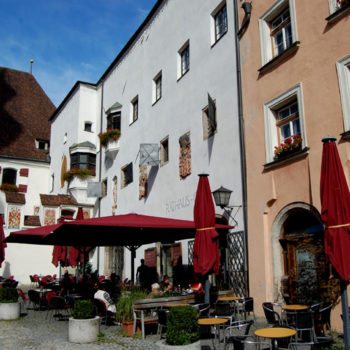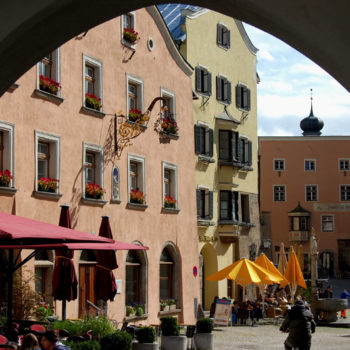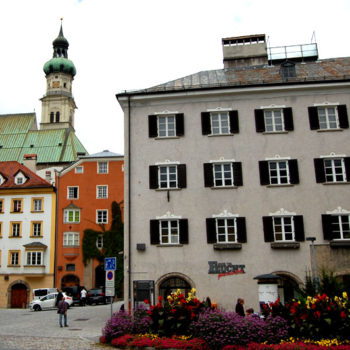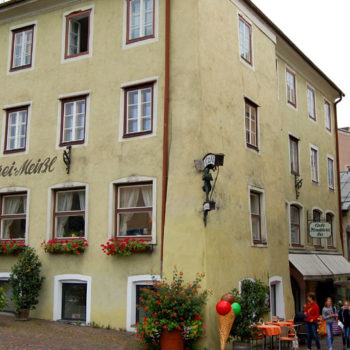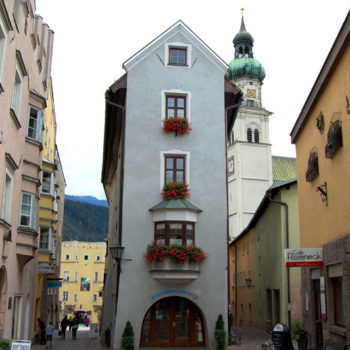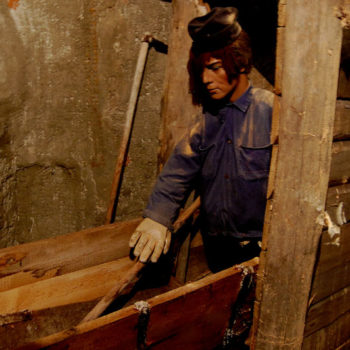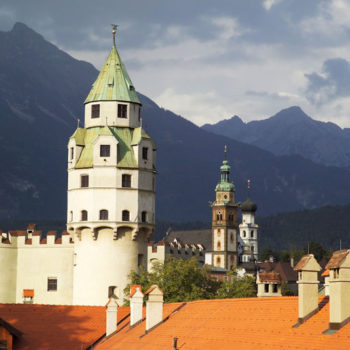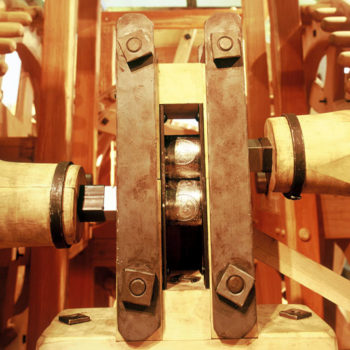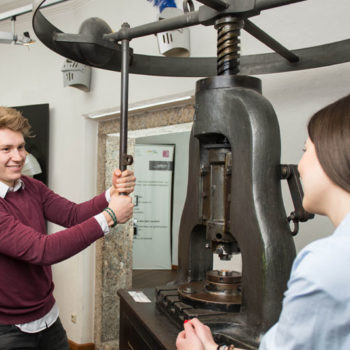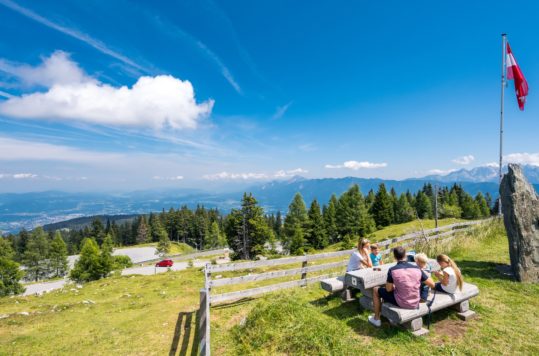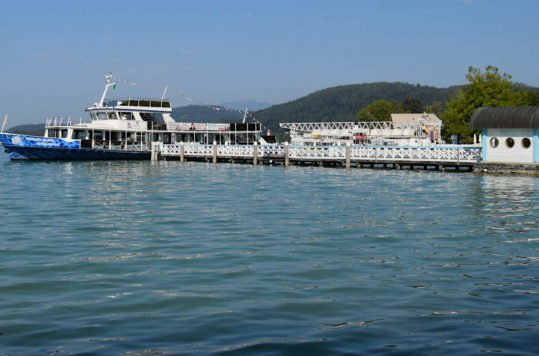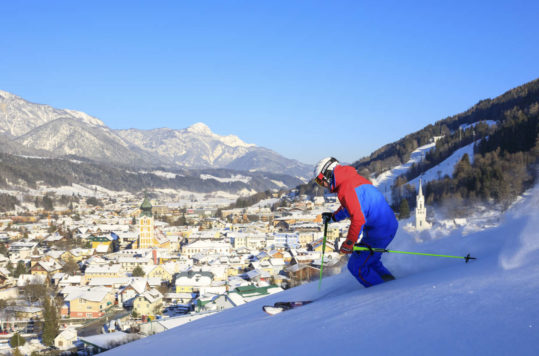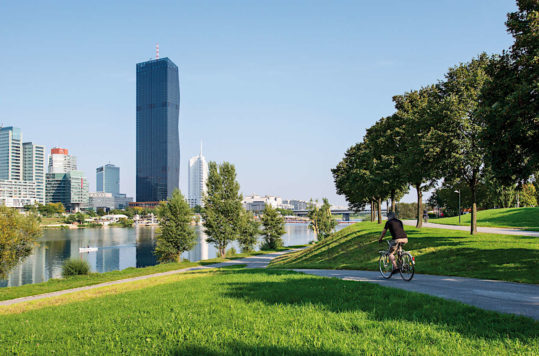Hall in Tirol is one of Austria’s best-preserved and finest historical cities. Surrounded by the alps, with hiking and skiing areas just around the corner, Hall is worth a visit, summer and winter.
A little in the shadow of Innsbruck, which is only 10 kilometres further west, Hall does not receive visits from countless busloads of tourists. Something that we appreciated when we strolled around in picturesque Hall. We love these small historic cities in Austria. The hustle and bustle of daily life make Hall much more than an “open air” museum and creates a pleasant atmosphere. People shop and sip cappuccinos at outdoor cafes while tourists photograph the lovely buildings.
Second only to Vienna
We went to Hall because it’s supposedly one of the finest small towns in Austria. It took a few hundred years to get there. Hall received city status already in 1303, but the city reached its peak when the Habsburg Empire’s coin stamping was moved here from Meran (today in South Tyrol) in 1477. In the 15th and 16th centuries Hall was one of the most significant cities in the vast Habsburg Empire. It is said that only the capital Vienna was more important in the Empire than Hall. It may seem strange for visitors today, but it’s true. The well-preserved old town in Hall is a testimony of the former splendour and riches. It offers a lovely old town you can ramble around and enjoy within a few hours.
<< Click on the images to enlarge >>
Rambling around in historic Hall
After picking up a city map and receiving some info at the local tourist office at Burg Hasegg, we suggest you take a coffee at one of the cafés at Oberer Stadtplatz, the centrepiece of the historic city centre. Most small streets also run out of this square, so it is an excellent place to start the city walk. The old town is only around 400 x 300 meters, so there is no danger of getting lost. Take your time and do not forget to look up, as the beautiful houses often have nicer facades at upper levels than down the street level. The town has a long and important history which you can see in Hall’s museums. We visited a couple of them and did not regret it. But first, a few words about salt and how Hall got its name.
The City of Salt
You may be familiar with the word “Hall”, which occurs in several place names in Austria. The most famous of the “Hall towns” is Hallstatt. In addition, there is Hallein. Moreover, the small Tyrolean town Hall also obtained its name from the salt (hall) extraction. From around the 1300s until the last salt mines closed in 1967, large-scale salt mining occurred in the surrounding mountains. If you want to know a little more and get a feel of the hard life in the salt mines during the Middle Ages, visit the Bergbaumuseum (mining museum). You find a mock salt mine in the narrow basements of a so-called Bürgerhaus, where wealthy citizens lived in the Middle Ages. Sure, it neither has the noise, the smell, nor the mouldy air of a real mine, but the equipment and the replica of the narrow shafts give you a little insight into the terrible working conditions. The one-hour guided tour costs € 5. Another highlight and mandatory attraction in Hall is the medieval castle Hasegg and the Mint Museum.
Advertisement
Burg Hasegg and Mint Museum
The castle itself is perhaps not the most spectacular in Austria, but in combination with the Mint museum, you get a small introduction to the medieval history of Austria. We will not get into the monetary system and its creation, but the replica of the world’s first mechanical coin press, which you see in the museum, was of great importance for using coins. The massive wood machine, which produced up to 4000 silver coins daily, is impressive. Hall likes to be called the cradle of the modern-day “Dollar”. Before leaving the museum, you can stamp your little coin as a souvenir. After an introduction to the coin’s history, you definitely should climb the Mint Tower. The around 200 steps will be forgotten as soon as you see the view from the top.
Out of town
We opted to stay in idyllic Tulfes (10 min / 7 km from the Hall by car), almost 400 meters higher in the Alps. Hall and surrounding area of many beautiful nature experiences, of course, with its location in the middle of the Alps. Although there was no time during this visit, we were inquiring about possible activities. Not surprisingly, we are, after all, in Austria. The hiking possibilities range from simple walking routes that lead you through idyllic alpine villages to advanced hiking trips deep into the mountains. Thus, you can easily combine nature and history within 2-3 days in Hall.
For more info:
Hall-Wattens Tourist Office
Tirol Tourismus
Parking
We parked at Salinenparkplatz by the Tourist Office, which is just after the bridge over the river Inn, as you arrive from the A12 motorway. It costs just a few Euros and you can park up to 3 hours.
By train
Hall in Tirol is on the mainline between Innsbruck and Vienna and has frequent connections in both directions.

